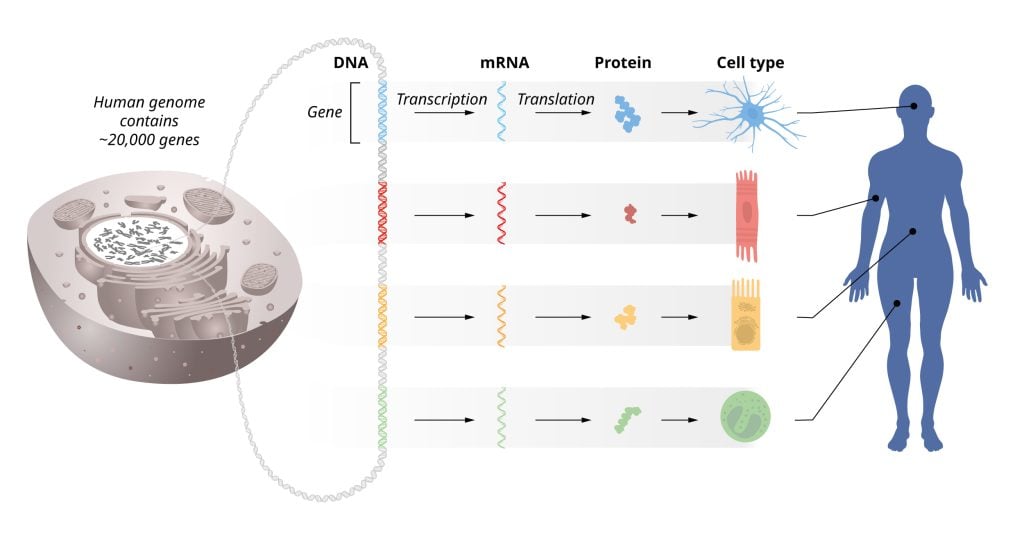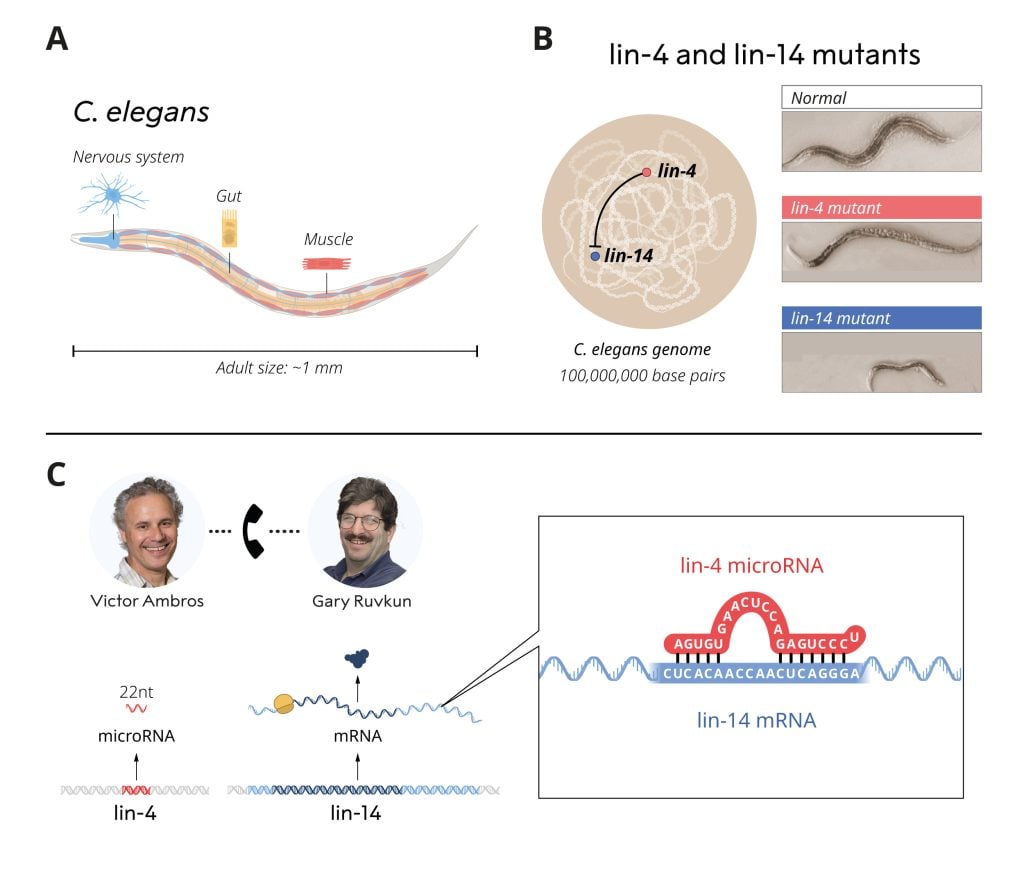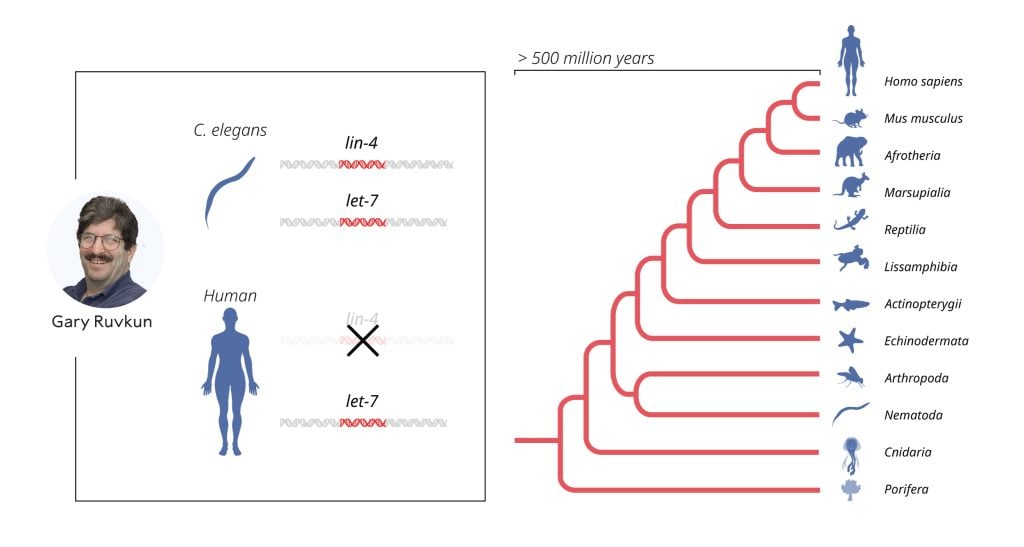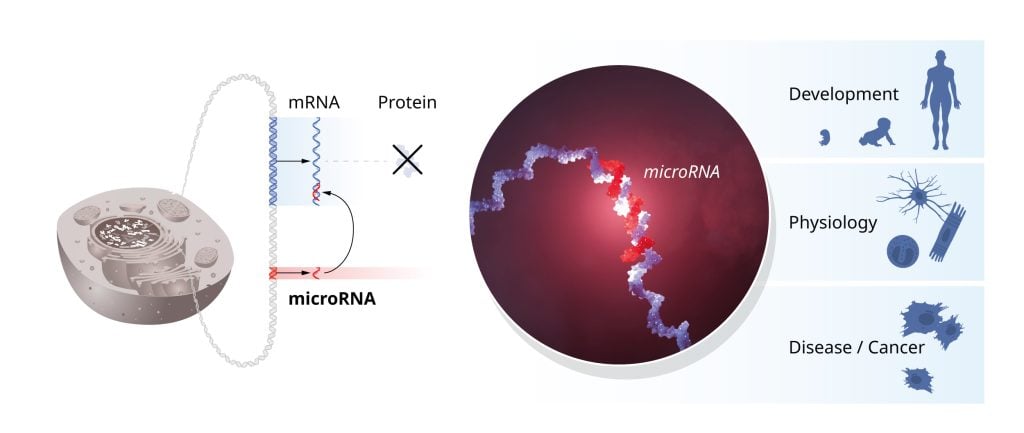Press release
English
English (pdf)
Swedish
Swedish (pdf)

2024-10-07
The Nobel Assembly at Karolinska Institutet
has today decided to award
the 2024 Nobel Prize in Physiology or Medicine
jointly to
Victor Ambros and Gary Ruvkun
for the discovery of microRNA and its role in post-transcriptional gene regulation
This year’s Nobel Prize honors two scientists for their discovery of a fundamental principle governing how gene activity is regulated.
The information stored within our chromosomes can be likened to an instruction manual for all cells in our body. Every cell contains the same chromosomes, so every cell contains exactly the same set of genes and exactly the same set of instructions. Yet, different cell types, such as muscle and nerve cells, have very distinct characteristics. How do these differences arise? The answer lies in gene regulation, which allows each cell to select only the relevant instructions. This ensures that only the correct set of genes is active in each cell type.
Victor Ambros and Gary Ruvkun were interested in how different cell types develop. They discovered microRNA, a new class of tiny RNA molecules that play a crucial role in gene regulation. Their groundbreaking discovery revealed a completely new principle of gene regulation that turned out to be essential for multicellular organisms, including humans. It is now known that the human genome codes for over one thousand microRNAs. Their surprising discovery revealed an entirely new dimension to gene regulation. MicroRNAs are proving to be fundamentally important for how organisms develop and function.
Essential regulation
This year’s Nobel Prize focuses on the discovery of a vital regulatory mechanism used in cells to control gene activity. Genetic information flows from DNA to messenger RNA (mRNA), via a process called transcription, and then on to the cellular machinery for protein production. There, mRNAs are translated so that proteins are made according to the genetic instructions stored in DNA. Since the mid-20th century, several of the most fundamental scientific discoveries have explained how these processes work.
Our organs and tissues consist of many different cell types, all with identical genetic information stored in their DNA. However, these different cells express unique sets of proteins. How is this possible? The answer lies in the precise regulation of gene activity so that only the correct set of genes is active in each specific cell type. This enables, for example, muscle cells, intestinal cells, and different types of nerve cells to perform their specialized functions. In addition, gene activity must be continually fine-tuned to adapt cellular functions to changing conditions in our bodies and environment. If gene regulation goes awry, it can lead to serious diseases such as cancer, diabetes, or autoimmunity. Therefore, understanding the regulation of gene activity has been an important goal for many decades.

In the 1960s, it was shown that specialized proteins, known as transcription factors, can bind to specific regions in DNA and control the flow of genetic information by determining which mRNAs are produced. Since then, thousands of transcription factors have been identified, and for a long time it was believed that the main principles of gene regulation had been solved. However, in 1993, this year’s Nobel laureates published unexpected findings describing a new level of gene regulation, which turned out to be highly significant and conserved throughout evolution.
Research on a small worm leads to a big breakthrough
In the late 1980s, Victor Ambros and Gary Ruvkun were postdoctoral fellows in the laboratory of Robert Horvitz, who was awarded the Nobel Prize in 2002, alongside Sydney Brenner and John Sulston. In Horvitz’s laboratory, they studied a relatively unassuming 1 mm long roundworm, C. elegans. Despite its small size, C. elegans possesses many specialized cell types such as nerve and muscle cells also found in larger, more complex animals, making it a useful model for investigating how tissues develop and mature in multicellular organisms. Ambros and Ruvkun were interested in genes that control the timing of activation of different genetic programs, ensuring that various cell types develop at the right time. They studied two mutant strains of worms, lin-4 and lin-14, that displayed defects in the timing of activation of genetic programs during development. The laureates wanted to identify the mutated genes and understand their function. Ambros had previously shown that the lin-4 gene appeared to be a negative regulator of the lin-14 gene. However, how the lin-14 activity was blocked was unknown. Ambros and Ruvkun were intrigued by these mutants and their potential relationship and set out to resolve these mysteries.

After his postdoctoral research, Victor Ambros analyzed the lin-4 mutant in his newly established laboratory at Harvard University. Methodical mapping allowed the cloning of the gene and led to an unexpected finding. The lin-4 gene produced an unusually short RNA molecule that lacked a code for protein production. These surprising results suggested that this small RNA from lin-4 was responsible for inhibiting lin-14. How might this work?
Concurrently, Gary Ruvkun investigated the regulation of the lin-14 gene in his newly established laboratory at Massachusetts General Hospital and Harvard Medical School. Unlike how gene regulation was then known to function, Ruvkun showed that it is not the production of mRNA from lin-14 that is inhibited by lin-4. The regulation appeared to occur at a later stage in the process of gene expression, through the shutdown of protein production. Experiments also revealed a segment in lin-14 mRNA that was necessary for its inhibition by lin-4. The two laureates compared their findings, which resulted in a breakthrough discovery. The short lin-4 sequence matched complementary sequences in the critical segment of the lin-14 mRNA. Ambros and Ruvkun performed further experiments showing that the lin-4 microRNA turns off lin-14 by binding to the complementary sequences in its mRNA, blocking the production of lin-14 protein. A new principle of gene regulation, mediated by a previously unknown type of RNA, microRNA, had been discovered! The results were published in 1993 in two articles in the journal Cell.
The published results were initially met with almost deafening silence from the scientific community. Although the results were interesting, the unusual mechanism of gene regulation was considered a peculiarity of C. elegans, likely irrelevant to humans and other more complex animals. That perception changed in 2000 when Ruvkun’s research group published their discovery of another microRNA, encoded by the let-7 gene. Unlike lin-4, the let-7 gene was highly conserved and present throughout the animal kingdom. The article sparked great interest, and over the following years, hundreds of different microRNAs were identified. Today, we know that there are more than a thousand genes for different microRNAs in humans, and that gene regulation by microRNA is universal among multicellular organisms.

In addition to the mapping of new microRNAs, experiments by several research groups elucidated the mechanisms of how microRNAs are produced and delivered to complementary target sequences in regulated mRNAs. The binding of microRNA leads to inhibition of protein synthesis or to mRNA degradation. Intriguingly, a single microRNA can regulate the expression of many different genes, and conversely, a single gene can be regulated by multiple microRNAs, thereby coordinating and fine-tuning entire networks of genes.
Cellular machinery for producing functional microRNAs is also employed to produce other small RNA molecules in both plants and animals, for example as a means of protecting plants against virus infections. Andrew Z. Fire and Craig C. Mello, awarded the Nobel Prize in 2006, described RNA interference, where specific mRNA-molecules are inactivated by adding double-stranded RNA to cells.
Tiny RNAs with profound physiological importance
Gene regulation by microRNA, first revealed by Ambros and Ruvkun, has been at work for hundreds of millions of years. This mechanism has enabled the evolution of increasingly complex organisms. We know from genetic research that cells and tissues do not develop normally without microRNAs. Abnormal regulation by microRNA can contribute to cancer, and mutations in genes coding for microRNAs have been found in humans, causing conditions such as congenital hearing loss, eye and skeletal disorders. Mutations in one of the proteins required for microRNA production result in the DICER1 syndrome, a rare but severe syndrome linked to cancer in various organs and tissues.
Ambros and Ruvkun’s seminal discovery in the small worm C. elegans was unexpected, and revealed a new dimension to gene regulation, essential for all complex life forms.

Illustrations
The illustrations are free to use for non-commercial purposes. Attribute ”© The Nobel Committee for Physiology or Medicine. Ill. Mattias Karlén”.
Illustration: The flow of genetic information from DNA to mRNA to proteins (pdf)
Illustration: Studies on C. elegans (pdf)
Illustration: Gary Ruvkun cloned let-7, a second gene encoding a microRNA (pdf)
Illustration: The seminal discovery of microRNAs (pdf)
Key publications
Lee RC, Feinbaum RL, Ambros V. The C. elegans heterochronic gene lin-4 encodes small RNAs with antisense complementarity to lin-14. Cell. 1993;75(5):843-854. doi:10.1016/0092-8674(93)90529-y
Wightman B, Ha I, Ruvkun G. Posttranscriptional regulation of the heterochronic gene lin-14 by lin-4 mediates temporal pattern formation in C. elegans. Cell. 1993;75(5):855-862. doi:10.1016/0092-8674(93)90530-4
Pasquinelli AE, Reinhart BJ, Slack F, Martindale MQ, Kurodak MI, Maller B, Hayward DC, Ball EE, Degnan B, Müller P, Spring J, Srinvasan A, Fishman M, Finnerty J, Corbo J, Levine M, Leahy P, Davidson E, Ruvkun G. Conservation of the sequence and temporal expression of let-7 heterochronic regulatory RNA. Nature. 2000;408(6808):86-89. doi:10.1038/35040556
Read more about this year’s prize
Victor Ambros was born in 1953 in Hanover, New Hampshire, USA. He received his PhD from Massachusetts Institute of Technology (MIT), Cambridge, MA, in 1979 where he also did postdoctoral research 1979-1985. He became a Principal Investigator at Harvard University, Cambridge, MA in 1985. He was Professor at Dartmouth Medical School from 1992-2007 and he is now Silverman Professor of Natural Science and professor of molecular medicine at UMass Chan Medical School in Worcester, MA.
Gary Ruvkun was born in Berkeley, California, USA in 1952. He received his PhD from Harvard University in 1982. He was a postdoctoral fellow at Massachusetts Institute of Technology (MIT), Cambridge, MA, 1982-1985. He became a Principal Investigator at Massachusetts General Hospital and Harvard Medical School in 1985, where he is now Professor of Genetics.
Illustrations: © The Nobel Committee for Physiology or Medicine. Illustrator: Mattias Karlén
The Nobel Assembly, consisting of 50 professors at Karolinska Institutet, awards the Nobel Prize in Physiology or Medicine. Its Nobel Committee evaluates the nominations. Since 1901 the Nobel Prize has been awarded to scientists who have made the most important discoveries for the benefit of humankind.
Nobel Prize® is the registered trademark of the Nobel Foundation
Nobel Prizes and laureates
Six prizes were awarded for achievements that have conferred the greatest benefit to humankind. The 12 laureates' work and discoveries range from proteins' structures and machine learning to fighting for a world free of nuclear weapons.
See them all presented here.
